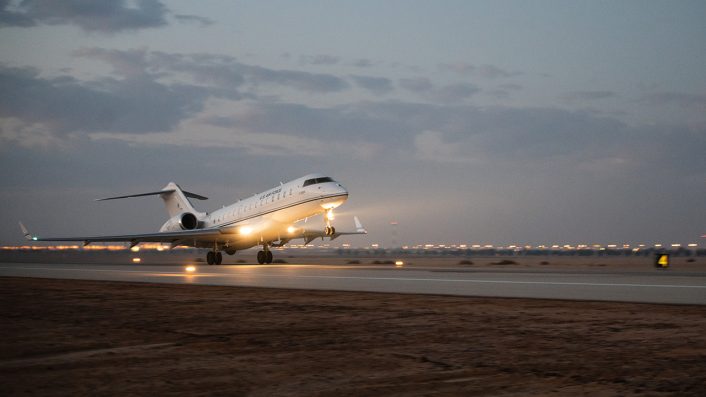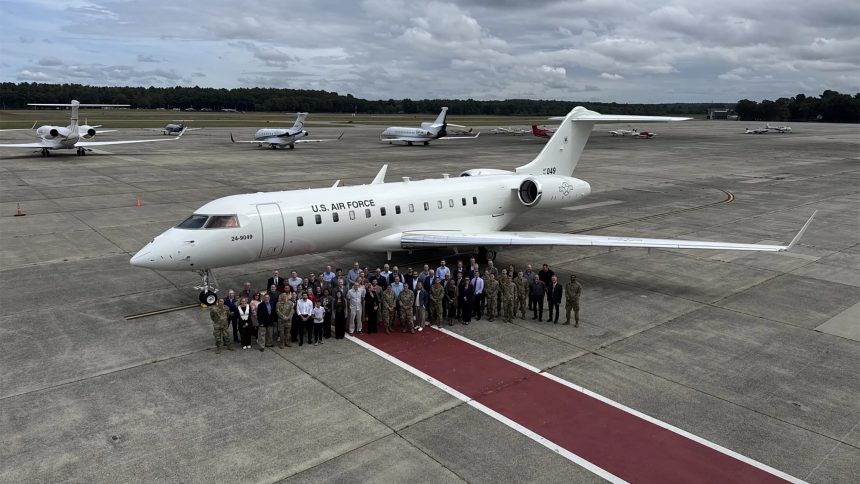Bombardier Defense has announced the delivery of the U.S. Air Force’s ninth Global 6000 for the E-11A BACN program.
The ninth aircraft for the U.S. Air Force’s E-11A Battlefield Airborne Communications Node (BACN) program was welcomed in a ceremony held at Hanscom Air Force Base, Massachusetts, in September 2025. Hanscom is the headquarters of the BACN program office and is responsible for equipping the aircraft with the BACN payload, upon which it will become an E-11A.
Based on Bombardier’s highly successful Global executive jet platform, the E-11A serves as the primary operational implementation of the Battlefield Airborne Communications Node concept, also known as BACN or ‘Bacon’. BACN was developed as a result of lessons learned during operations in the mountainous terrain of Afghanistan, where line of sight communications between different units could frequently become hampered by the terrain. Instead of communicating directly with each other, different units would relay their communications and datalinks through a BACN-equipped aircraft operating at high altitude.
#BombardierDefense delivers 9th Global aircraft to the @usairforce for Battlefield Airborne Communications Node (#BACN) Program. https://t.co/lrHptLM6FN pic.twitter.com/xS3aeEN9t0
— Bombardier (@Bombardier) September 22, 2025
Technology on board the aircraft not only allows these communications to be routed through to other destinations, but also facilitates the translation of otherwise incompatible datalink protocols. Initial trials of the technology took place on NASA WB-57 Canberra aircraft which made unusual deployments to Afghanistan. The extraordinary altitude capabilities of the WB-57 made it a perfect fit for the BACN mission. The equipment would later be fitted to the Global platform, with a lower but still impressive service ceiling of 51,000 feet. Three EQ-4B Global Hawks were deployed during Operation Inherent Resolve in the BACN role, but this unmanned capability was withdrawn in 2021 in favor of an increased number of E-11As.

A 2020 crash in Afghanistan reduced the then fleet of E-11As from four to three, but the announcement of an order for six additional airframes followed the year afterwards. Since the U.S. withdrawal from Afghanistan, the E-11A fleet has moved from being effectively a deployed-only capability to a more traditional presence in the U.S. Air Force with squadrons and aircraft based in the U.S. and forward deployed overseas as necessary. In May 2025, a U.S.-based E-11A made the type’s first ever public appearance at an airshow.
An USAF E-11A (22-9048) is arriving at Souda AB. The aircraft is a specialized communications relay platform, often referred to as BACN (Battlefield Airborne Communications Node), designed to extend and bridge communication between different systems and forces on the battlefield. pic.twitter.com/T4IbygbNpe
— itamilradar (@ItaMilRadar) September 4, 2025
Overseas operations have continued, though, with the aircraft notably helping to coordinate multinational aid drops over Gaza in June 2024. The primary operating base for the E-11A in the Middle East is presently understood to be Prince Sultan Air Base in Saudi Arabia. With the Global platform’s exceptional endurance, jets from this base can provide the BACN role over effectively any location in the Middle East.
Jean-Christophe Gallagher, Executive Vice President of Bombardier Defense, said “At Bombardier Defense, we are honored to see our reliable, high-performing Global aircraft serve the United States Air Force in critical missions worldwide through the BACN program,” and added “We are grateful for the longstanding trust of the U.S. Air Force, and we look forward to continuing to support the operational needs of the United States.”
Bombardier Defense refers to the E-11A’s BACN role as ‘Wi-Fi in the sky’, but members of the U.S. Air Force who operate the E-11A say that phrase only scratches the surface of what the platform is capable of.
The new airframe, serial number 24-9049, was delivered by the manufacturer under the civilian registration N898M. Federal Aviation Administration records show this registration as having been registered in October 2024 under an ‘experimental’ classification.
Brand new USAF E-11A N898M arrived at KBDL on September 5th and is now pinging on the ground with military hex #AF83F0 as BBA47 pic.twitter.com/ZdwEKyLyor
— Nick H. ✈︎ (@N214WN) September 9, 2025
No comment was made by Bombardier Defense as to how many more aircraft are expected to be delivered. While the delivery of the ninth aircraft would seem to bring the Air Force up to the planned fleet strength intended after the 2021 order, it’s possible that some of the oldest E-11A airframes will be withdrawn to make room for new examples. This would be most likely for 11-9001, which is a unique and easily recognisable aircraft in the fleet due to its large, and now redundant, radomes that were fitted during its role as a testbed for the Royal Air Force Sentinel R1.

Originally registered as C-FBGX, 11-9001 started life as the first flying prototype for the Global Express program. The airframe is rapidly approaching 30 years of age, and likely chalked up a significant amount of flying hours when deployed operationally. An E-11 was included on the U.S. Air Force’s divestiture list for the 2025 financial year, but as yet we have no update on 11-9001’s status.









